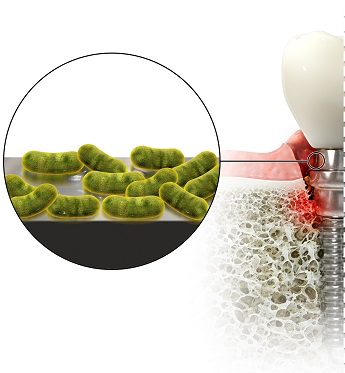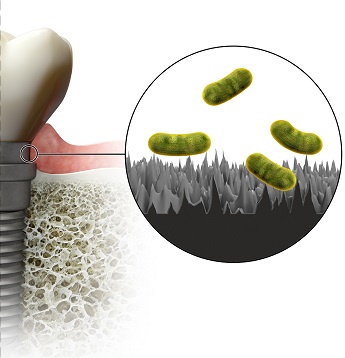New nanotechnological solution prevents bacteria from sticking to surface of implants. It solves a growing problem with infections.
Many people walk around with an artificial implant in their body without giving it a further thought. It could be a dental implant to replace a missing tooth, or a hip implant to replace a damaged hip socket. While implants help when the body fails, they are also associated with a risk.
In the United States alone, 17 million people are hospitalized each year with a chronic infection—of whom at least 550,000 die. Studies show that the high number of chronic infections is related to an increase in the number of patients having an implant procedure.
“What can happen is that the body’s bacteria can settle on the surface of the implant in a layer so thin as to remain undetected by the immune system. This layer develops into a biofilm and means that we are walking around with these implants, which could potentially be small ticking time bombs, without any possibility of reacting before it turns into a chronic infection,” explains Professor Paul Michael Petersen, professor and Head of Section at DTU Fotonik. He believes the problem is one of the most overlooked in the health sector.
Together with Associate Professor Yiyu Ou at DTU Fotonik, he has developed a technological solution that can prevent infections from occurring. Using a special method, the researchers use nanostructures to create a jagged surface on the implant so bacteria cannot stick. Instead, the jagged points ‘puncture’ the bacterial cell membrane causing the bacteria to die.
So far, laboratory tests show that the proportion of bacteria that get stuck is reduced by 90 per cent compared with implants that have a smooth surface.
“I’ve been really surprised at how good our technology is at breaking down the infections. The efficacy and results have far exceeded my expectations,” says Paul Michael Petersen.
Greater durability
The idea of fabricating nanostructures to kill bacteria is not really new in itself. Here, the researchers are up against competitors that are already cooperating with the market’s major medical companies.
However, where their competitors ‘coat’ the surface of the implant with nanostructures, the researchers from DTU Fotonik have developed a method whereby the nanostructures are incorporated into the implant itself.
"We haven’t come across anyone else using this method. With our method the protection remains on all surfaces, even the complicated ones."
Yiyu Ou, Associate Professor, DTU Fotonik
“Using a patented technology, we insert the structures into the implant itself which is made of titanium. It works just like when you engrave something onto a material,” explains Paul Michael Petersen.
The researchers emphasize that the method protects the implant from infections for more than ten years. In comparison, the competitors’ coating method only lasts for up to five years.
“We haven’t come across anyone else using this method. The integration into the design itself is what is attractive about our invention. With our method the protection remains on all surfaces, even the complicated ones,” says Yiyu Ou.
In 2021, the invention led to the establishment of the spinout company Adina Technologies and today the researchers have a patent on the solution.
This is how the technology prevents infections caused by dental implants

Grafik: Claus Lunau
|

|

|
A dental implant consists of three parts:
1: The crown that sits in the mouth and acts as the original tooth.
2: The abutment part, which connects the crown and the implant itself. The abutment is made of the biocompatible metal titanium, which means that tissue can grow on the surface.
3: The implant itself, which is also made of titanium. The implant is screwed into the jawbone, where the bone tissue grows in and attaches to the surface of the implant so that it stabilizes.
|
It is a widespread problem that bacteria the oral cavity can be the cause of chronic infections around the dental implant.
The infections occur when the bacteria get stuck on the surface, which allows them to multiply and form a colony of bacteria, also called a biofilm.
The biofilm causes infection in the supporting tissues around the implant. The supporting tissues break down and the tight connection between bone and implant is destroyed. Small openings, called periodontal pockets, form around the implant and the biofilm spreads down the implant itself. In the worst case the implant can rock loose and fall out.
|
The nanotechnology from Adina Technologies prevents cronic infections by incorporating nanostructures into the titanium parts of the dental implant from the start.
As a result, a ‘jagged’ surface is created with structures smaller than the bacteria’s own size.
When a bacteria approaches the surface, the small structures puncture the cell membrane of the bacteria. That kills the bacteria and makes it impossible for it to divide and multiply.
|
‘Great interest from dentists’
The long-term aim is a general dissemination of the solution to all existing implants. However, the focus is primarily on dental implants where the need is largest.
“The number of patients who want replacement of missing teeth is very large and is growing every year due to an aging population. With age, the risk of losing one or perhaps more of your own teeth increases, and today people will not except going toothless, but would like to replace the missing tooth with a dental implant,” says Yiyu Ou.
According to Swedish research, 45 per cent of patients with a dental implant get a infection within ten years. The researchers have identified there is a great need among dentists in Denmark to be able to treat or, even better, prevent these infections.
“There are a lot of dentists who are anxious to test our technology and I’m confident that we’ll get a quick approval. The nanostructures have already been made and approved in advance—just with coating as a method,” says Paul Michael Petersen.
Next step is further tests in the laboratory and subsequently in a selection of Denmark’s approximately 1,000 dental clinics. The researchers expect the technology to be commercialized within a few years.